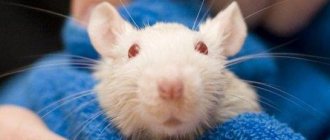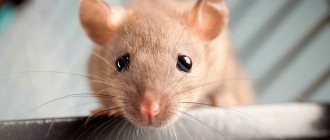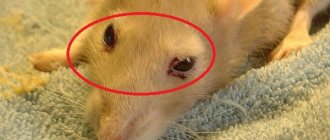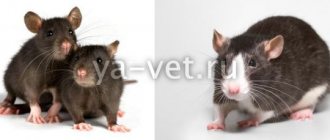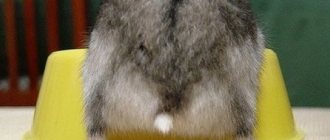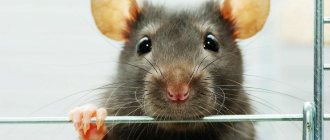Decorative rats are neat animals for which their owners provide decent living conditions.
Unfortunately, parasites are found in rats even if they are kept comfortably in an apartment, with timely cleaning and regular disinfection of the rodent cage. If your pet rat has become restless, often itches and bites fur with its teeth, scratches, bloody crusts, and areas of baldness appear on its body, then you should suspect that your furry friend has external or subcutaneous parasites. In such cases, it is advisable to immediately take the pet to a veterinary clinic to clarify the diagnosis and prescribe effective treatment, otherwise rat parasites can cause exhaustion and death of the animal.
Why do parasites appear in decorative rats?
Rat breeders are often faced with a situation where, despite the desire to surround their pet with care, they are found to have parasitic animals.
Did you know? In India there is a Rat Temple - Karni Mata. It is home to several tens of thousands of these animals.
Sources of infection can be:
- Poor quality fillers. When purchasing compounds made from hay and sawdust at a suspiciously low cost and at dubious points of sale, there is a risk of ticks and lice-eaters appearing in the apartment. You should also refuse the services of online stores - they may sell you goods of the worst quality.
- Communication with infected animals. Parasitic insects can appear in the house from another pet.
- External environment. The owner of the house can bring various harmful insects from the street (on his hands and clothes).
Symptoms of infection
Flea bites cannot be ignored - when the proboscis is inserted under the skin, they do not inject any anesthetic enzymes, like other blood-sucking insects.
In addition, the wounds are very visible externally - the parasites cause irritation on the skin, which is accompanied by itching, swelling, and redness. Most often, it is bites on a person that reveal their presence in the house.
If a rat has fleas, scratching marks, bald spots and scabs will be noticeable on its body. The pet will jump sharply from time to time, reacting in a similar way to painful bites.
Other pets exhibit the same symptoms as when infected with other types of fleas - nervousness, constant scratching of the skin, especially in hard-to-reach places.
How to tell if a rat has parasites
You should pay more attention to the behavioral reactions of an ornamental rodent and regularly inspect its body. Particular attention is paid to the body and ears. It is also important to find out information about the specific parasite that attacked your furry friend. Signs of the presence of a particular pest are described in detail below.
Fleas
The rat flea is an ancient and very unpleasant parasite that feeds on blood. A flea carrier can be a cat, dog or wild rodent. After the pest lays eggs, your furry friend will additionally be subjected to larval bites. When infected with this insect, the animal behaves restlessly and scratches its skin, and a dry crust forms in that area. There is a possibility of developing anemia.
You will be interested to know what to do if your pet rat has a cold.
Lice
The rat louse is a dangerous invertebrate creature with an elongated flat body. These pests also suck rat blood. It is almost impossible to detect them due to their too small size.
Only eggs can be recognized. The pet constantly suffers from itching, is capricious, actively scratches its tummy, and does not respond to its owner. When lice attack rodents, anemia, typhus and hemobartonellosis often occur.
lice eaters
The lice beetle is a small red parasite with a body measuring 1 mm. It is difficult to recognize an adult, but you can notice its eggs. They resemble dandruff stuck to the fur. Infection is manifested by the animal's anxiety, nervous behavior, refusal to eat, and rapid weight loss.
Video: lice eaters on a rat
Bedbugs
The bedbug is a rather harmful arthropod, the parasitic activity of which can lead to blood poisoning in a rat. This type of ectoparasite settles in almost every corner of the apartment: under baseboards, on linens, in carpets, and so on. Bedbugs begin to parasitize animals when they lack nutrients.
Important! Bedbugs are invisible to
the naked eye.
Only a veterinarian can determine the exact cause of a pet rat’s anxiety. Pets suffer from severe itching. Treatment cannot be delayed - inattention to the animal can result in a more difficult fight against parasitic living creatures, and in severe cases, lead to death.
Ticks
It is also impossible to notice a tick on a rat’s body. Scraping done by a veterinarian does not always give a reliable result. However, there are indirect signs - hair loss, the appearance of bloody wounds on the body.
An ear parasite is immediately noticeable. At the edges of the ears you can see characteristic tubercles. If you treat the situation negligently, the skin of your ears will soon be corroded.
Appearance
These insects are divided into varieties; the most common type of flea is the southern rat flea.
With the naked eye it is impossible to distinguish them from other relatives - dogs, cats and domestic ones. Only a specialist can determine the species under a microscope.
The rat flea looks similar to other representatives of the genus: the body has an elongated shape, flattened on the sides, the back part is raised due to long jumping limbs.
It is covered with chitinous cover and has a dark brown color. Length – from 3 to 5 mm.
How to treat an infected rat
It is advisable that the treatment of an infected rodent be carried out by specialists from a veterinary clinic. A doctor who deals with the recognition and treatment of rodent diseases is called a ratologist. He will clarify the type of parasite, prescribe the most effective tactics and recommend a drug that will help a specific breed of domestic rat. But if for some reason you do not have the opportunity to contact a specialist, you can treat your pet yourself.
Find out why your pet rat itches.
What can be processed
If signs of the presence of parasites are detected, you need to get rid of them using the following effective medications:
- “Unoiled.” Dilute 2 ampoules with water, then thoroughly treat the entire surface of your pet’s body. Pay special attention to damaged areas of the skin. Keep the rat wrapped in a towel until the solution dries. This is necessary in order to prevent the animal from licking the drug. After 10 days, repeat the procedure.
- "Frontline" (spray). Spray the product twice on your pet's body. Hold the rat in your arms until the preparation dries. After 7–10 days, repeat the procedure.
- "Bars" (insectoacaricidal spray for cats and dogs). The solution must be sprayed onto the withers and also wiped over the affected areas of the skin. Repeat these procedures after two weeks.
A separate group of drugs has been developed to combat subcutaneous and ear mites:
- "Stronghold" (drops, bottle comes with a purple cap). Dosage at the withers - 0.01 ml per 100 g of animal weight.
- “Lawyer” (drops on the withers).
- “Dironet Spot-on” (drops on the withers).
- "Prasicide-complex" (drops). One application is enough to save the animal from subcutaneous ticks.
If parasites are detected on one pet, all animals living in the house will need treatment. In addition, it is important to carry out general cleaning and disinfection in all rooms. The cage, feeder, water bowl and all toys must also be disinfected. And the bedding and filler need to be changed. All wooden objects in the cage (sticks, toys) should be removed from the house.
Important! During the treatment period, the rat's claws must be trimmed to prevent scratching of the skin.
Prevention
Both external and internal parasites cause a lot of anxiety and trouble for the pet and its owner. In addition, parasitic diseases that are not treated promptly can lead to serious complications for the animal’s health. Therefore, it is better to pay attention to the prevention of all types of parasites. The following measures will help avoid infection:
- Regular cleaning of the cage . You need to wash the tray and change the filler at least 3 times a week. And once a month it is necessary to completely disinfect the cage and everything in it.
- Buying quality filler . Insects are almost never found in products from trusted manufacturers. Additionally, to avoid troubles, it is necessary to store the filler in sealed bags. If this is not possible, it is better to buy filler in small packages that are quickly used up.
- Sending newly acquired rats to quarantine . It is advisable to place purchased animals in a separate cage for the first 2-3 weeks. This time is enough to check your pet for parasites and, if necessary, treat it.
- Fencing a decorative rat from other domestic animals . First of all, from strangers. This applies to those who like to receive guests with their pets.
- Compliance with personal hygiene rules . You should not touch your fluffy immediately after being outside, especially in public places. First you need to change clothes and wash your hands thoroughly with soap. And only after that, start communicating with pets.
- Feeding with quality products . Industrial food for decorative rats usually does not pose any danger. However, during long-term storage, insects may appear in the bag. But natural nutrition can become a potential source of danger. Therefore, before serving to the rat, it is necessary to thoroughly wash fruits and vegetables, and heat treat meat and fish.
Knowing what causes parasites in rats and how to get rid of ticks, lice, fleas and worms, every owner will be able to provide their pet with a healthy and happy life. The main thing is to take precautions in time. And if you still cannot avoid infection, contact a veterinary clinic.
How to prevent parasites
To ensure that your pet does not have a negative experience of being infected with parasites, you should take care of keeping the animal comfortable in the apartment and strictly follow the following precautions :
- keep the cage clean - clean the inside in a timely manner and periodically disinfect it;
- change the water in the drinking bowl more often;
- provide the rat with adequate nutrition;
- ventilate all rooms daily;
- every time after returning from the street, wash your hands and take off dirty clothes, especially before interacting with your pet;
- and another important condition is to purchase fillers and food exclusively in zoological stores with a good reputation.
What is the danger to humans?
The rat flea can be a carrier of a dangerous disease. If such an insect bites a person, an infection enters the body along with the saliva. In the worst case scenario, it will turn out to be a plague bacillus - the causative agent of the plague.
Other possible diseases include:
- hepatitis (its different forms);
- AIDS;
- typhoid fever;
- encephalitis;
- salmonellosis;
- brucellosis;
- anthrax.
Like house fleas, rat fleas leave behind many unpleasant symptoms, some of which require special treatment and can be dangerous.
Consequences of a bite
After a rat flea bite, wounds remain on the skin, which bring physical and mental suffering to a person.
Most common symptoms:
- redness and swelling of the skin;
- burning, severe itching;
- elevated temperature;
- vomiting, diarrhea;
- difficulty breathing, feeling of chest tightness;
- headache (in the back of the head).
Sometimes sleep disturbances, weakness, and decreased performance occur. In case of severe allergic manifestations, the help of a doctor and specific treatment are necessary.
Source
Folk remedies for insects
Often, parents of young children are afraid to use chemicals to treat their apartments against parasites. There is also a way out of this situation - you can use folk recipes against fleas.
- The use of herbal infusions gives good results. You need to take dried herbs: wormwood, tansy and eucalyptus in proportions 2:1:1. Pour boiling water over them and leave to steep for at least 12 hours. Strain the resulting infusion and treat the apartment with it using a spray bottle. Be especially careful when spraying carpets, pet bedding, and furniture.
- Fleas do not like strong odors, including the scent of pine needles. Therefore, you can place pillows filled with pine sawdust around the house. In combination with bouquets of dried tansy they will give an excellent result.
- There is another interesting and effective remedy - a mixture of crushed garlic and brewer's yeast. You need to treat the floors with it and leave it for about 10 hours, then vacuum the surface. This method will help drive out fleas once and for all.
Considering how difficult it can sometimes be to get rid of parasites, it is better to take preventive measures. It is enough just to regularly clean the apartment and promptly treat pets with insecticides.
What is the danger of these pests to humans?
Rat fleas are extremely harmful to humans, as well as to animals. Their bites are very painful and have unpleasant consequences. Externally, the bite site is clearly visible; a red spot appears there, it is very itchy and slightly swollen. In sensitive people, a rat flea bite can cause an allergic reaction, including swelling of the upper respiratory tract and anaphylactic shock. Often these pests appear in homes where various rodents live as pets - rats, mice, gerbils, hamsters. People usually notice the presence of insects in the house when their pet's behavior changes, it often itches and appears restless, or if they themselves become a victim of these pests.
Just like other types of these parasites, the rat flea can cause pulicosis in humans . This is a common dermatological disease caused exclusively by flea bites.
Symptoms of bites may be as follows:
- Swelling at the site of the bite;
- Itching;
- Increased body temperature up to 40 °C;
- Skin rashes;
- Diarrhea;
- Headaches and nervous system disorders;
- Ulcers in the mouth and throat.
Appearance
These insects are divided into varieties; the most common type of flea is the southern rat flea.
With the naked eye it is impossible to distinguish them from other relatives - dogs, cats and domestic ones. Only a specialist can determine the species under a microscope.
The rat flea looks similar to other representatives of the genus: the body has an elongated shape, flattened on the sides, the back part is raised due to long jumping limbs.
It is covered with chitinous cover and has a dark brown color. Length – from 3 to 5 mm.
Rat fleas in the apartment: routes of entry and hiding places
Externally, to the naked eye, rat fleas are practically indistinguishable from the parasitic fleas of cats and dogs. Only under a microscope can one see the main differences of this species. Below is a photo of a rat flea at high magnification:
Actually, rat fleas are not just one species, but a whole genus of species of parasitic insects, the main hosts of which are rodents. Of these, the southern rat flea, a notorious carrier of the plague pathogen, parasitizes common gray rats and some other species of rodents.
By the way, fleas in rats do not necessarily belong specifically to the genus of rat fleas. They can also be parasitized by human, rabbit, dog, cat fleas and many other species.
Rat fleas look the same as most of their relatives: their small body, about 3 mm long, is flattened laterally and has a dark brown color. Fleas do not have wings, but their hind legs are much longer than the two pairs of front ones. Thanks to them, insects make simply huge jumps for their size: this little one can fly up to 30 cm after one push.
Rat fleas are temporary parasites of all their hosts. They do not live on the body permanently, but only jump on the animal in order to bite it and drink blood.
At the same time, the insects themselves are very attached to the resting places of their owner, so as to always have a source of food nearby. As a rule, insects settle in the nesting litter in the burrows of rats, gophers, gerbils, and marmots, and lay their eggs here.
Features of life
Adult rat fleas recognize their only food as blood. Their victims can be not only mice, rats and other rodents, but also cats, dogs, and even humans. Unlike many blood-sucking parasites, an anesthetic substance is not injected during the bite, since in case of danger they are able to leave the food object in a split second. The duration of a rat flea meal varies from 2 to 20 minutes.
Contrary to popular belief, this type of parasitic fauna does not spend its entire life on the body of the “host”, but also does not settle too far from it. Rat fleas in an apartment or house hide in secluded places and animal bedding.
Reproduction can occur both on the food source and outside it. Every day the female lays from 5 to 12 eggs. The qualities of a hen are not inherent to her and she can squeeze embryos out of herself while moving.
Features of the species and habitat
The highest concentrations of rat fleas are observed in tropical and subtropical regions, but some individuals successfully migrate throughout the world. The insect easily adapts to difficult conditions and can do without food for a long time.
The appearance of the parasite is not much different from other representatives of the order - dog or cat fleas. The body of an adult does not exceed 4 mm in length. The insect moves using 6 legs, two of which are jumping. The oval-shaped body is flattened, which, together with a durable chitinous shell, protects the flea from physical damage.
For reference! The optimal microclimate for the successful development of the parasite is a temperature of about +25⁰C with a humidity level of 60 to 75%. In one clutch, a female can have up to 400 eggs, which contributes to the rapid reproduction of the pest.
Source


